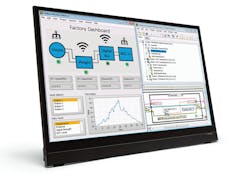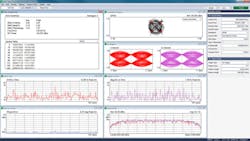This file type includes high resolution graphics and schematics when applicable.
Advanced test systems are necessary to meet today’s challenging time-to-market and performance requirements. As devices grow in complexity, software is proving to be an extremely vital aspect of RF/microwave testing. Sophisticated software tools are available to increase the efficiency of test environments. Automated test engineers, who need to develop innovative systems, can use these tools to develop solutions capable of meeting today’s demands. Various types of software intended to simplify the testing process are currently available.
To meet current demands, for example, engineers continue to use LabVIEW from National Instruments (NI) to develop test software solutions (Fig. 1). LabVIEW can be integrated with a variety of test instrumentation, ranging from traditional boxes to modular PXI-based hardware. The latest version of the software, LabVIEW 2015, offers several new features.
“LabVIEW 2015 includes several new enhancements that enable users to write code faster and write faster code,” said Haydn Nelson, senior product manager at NI. “These improvements include changes to the LabVIEW compiler itself along with new driver software like NI-RFmx. In the LabVIEW application development environment (ADE), NI has made significant improvements to load times, execution speed, and memory usage. Because RF measurements tend to be computationally intensive, each of these new enhancements in LabVIEW 2015 has ultimately improved test speeds in automated test applications.”
Nelson added, “NI-RFmx is an application programming interface (API) designed specifically with LabVIEW and the PXI platform in mind. It provides an intuitive programming measurement experience combined with advanced features for measurement parallelism. NI-RFmx has the capability to allow users to easily decouple RF signal-acquisition from measurement analysis. This is accomplished by means of an API that enables the instrument to acquire measurement data and perform analysis in parallel when conducting multiple measurements. Known as an asynchronous measurement, this had been difficult or even impossible to achieve with traditional instruments. But NI-RFmx makes asynchronous measurement parallelism possible. Asynchronous measurement parallelism takes advantage of multicore central processing unit (CPU) technology, enabling engineers to improve overall automated test speed—sometimes by an order of magnitude.”
Software Solutions for Wireless Test
Test software is an important aspect of automated test systems for wireless applications. As wireless devices become more complex, delivering quality products to the market in a timely fashion is even more challenging. Thus, test software is critical for both device characterization and high-volume production requirements. Fortunately, solutions are available to meet these demands.
As an example, LitePoint offers the IQfact+ calibration and verification software solution for wireless chipsets. IQfact+ supports wireless connectivity technologies, such as Wi-Fi, Bluetooth, ZigBee, Global Positioning System (GPS), near-field communications (NFC), and more. Its library includes more than 300 chipsets.
To facilitate test synchronization, IQfact+ controls both the LitePoint tester and the device-under-test (DUT). Chipset calibration algorithms are also provided by the software. The company claims that IQfact+ can enable test systems to be deployed in hours compared to a development time of weeks or even months for traditional test automation systems.
To support the demands of 4G LTE cellular standards, LitePoint offers the zSignal LTE software toolkit. Intended for compliance testing and characterization of LTE cellular devices, this test solution provides demodulation and vector signal analysis capabilities. Users are provided with the tools needed to generate and analyze LTE RF and baseband I/Q signals. Similarly, LitePoint’s zSignal WLAN software supports wireless-local-area-network (WLAN) applications.
Digital pre-distortion (DPD) techniques are being employed in many of the latest WLAN transceiver chipsets to improve power amplifier (PA) linearity. In response, LitePoint offers the zSignal DPD software, which is a DPD software toolkit for PA and front-end module (FEM) characterization and testing. This software has the capability to measure the nonlinearity of a PA, compute an inverse operation, and then create a pre-distorted RF signal that effectively linearizes the PA. When combined with the zSignal WLAN software, zSignal DPD supports PA/FEM DPD testing for IEEE 802.11 WLAN devices. Similarly, zSignal DPD supports PA/FEM DPD testing for LTE cellular devices when combined with the zSignal LTE software toolkit.
Heterogeneous Networks (HetNets) incorporate different varieties of small-cells. To support these networks, the PXI Maestro test system from Cobham Wireless was recently enhanced with the introduction of small-cell test capability (Fig. 2). The company’s ATE system is based on PXI modular instruments and the PXI Maestro test sequencing software. This introduction provides integrated device control software for Qualcomm Technologies’ FSM99xx based multi-mode enterprise, residential, and metro small cells.
The PXI Maestro test software integrates all the sequencing control needed to measure multiple DUTs. Users can test as many as four small cells in parallel with a single RF channel—a single vector signal analyzer and signal generator—by means of novel RF signal conditioning and intelligent test sequencing. The PXI Maestro small cell capability provides frequency coverage to 6 GHz for all LTE, LTE-A, and High Speed Packet Access (HSPA) bands.
Manufacturers Integrate Hardware with Software
Many companies regarded as test equipment suppliers are also developing their own custom software. The integration of hardware and software is intended to help users streamline the testing process. Many improvements to the test workflow can now be achieved by means of a more integrated approach. One improvement is combined functionality, as software is being used to enhance traditional instrument measurement capability.
For example, the SignalVu vector signal analysis software from Tektronix integrates the test process by combining the functionality of vector signal analyzers and spectrum analyzers with the trigger capabilities of digital oscilloscopes. The software, which is intended to be used with an MSO/DPO5000, DPO7000, or DPO/DSA/MSO70000-series digital oscilloscope, enables users to directly observe microwave signals without needing an external downconverter. All signals within the analog bandwidth of the oscilloscope can be captured into memory. RF, I/Q, and differential I/Q signals can be processed from any of the four oscilloscope inputs. SignalVu is intended to help validate designs for applications, such as wideband radar, high-data-rate satellite links, WLAN, and frequency-hopping communications.
For its part, Signal Hound is another company that has developed its own software (Fig. 3). The software, which is named Spike, provides performance enhancements to several of the company’s products. It allows all the SA-series spectrum analyzers and TG-series tracking generators to operate under the same open source GUI platform as the BB60C spectrum analyzer.
Spike, which is available free of charge, allows the SA-series models to function as real-time spectrum analyzers for 250-kHz sweeps and below. This functionality enables every RF event to be captured when using a span within 250 kHz. The software also enables sweep speeds to be as much as 8 times faster when using spans between 500 kHz and 2 MHz. Additionally, the tracking generators can now save 1000-point data files that can be used to normalize precise measurements with RF cables and/or antennas.
The Spike software was recently updated with the introduction of version 3.0.8. This version introduces real-time digital modulation analysis tools for the BB60C and BB60A spectrum analyzers. Constellation diagrams, symbol tables, error vector magnitude (EVM) measurement capability, and bit pattern matching analysis tools for a wide range of modulation types are provided. When used with a BB60C or BB60A, the updated software includes real-time tools to analyze digitally modulated signals with bandwidths to 27 MHz at frequencies from 9 kHz to 6 GHz.
With its Amplifier Test Bench software, Boonton (which is part of the Wireless Telecom Group) aims to provide an integrated approach to RF amplifier testing. This integration allows users to perform measurements with just a few mouse clicks. Advanced programming skills are not required, thus simplifying the user experience. The software enables automatic testing of RF amplifier parameters, among other features. Amplifier Test Bench, which supports both high-power and small-signal amplifiers, is intended to be used with the company’s 4540 and 4500B power meters. It also supports a variety of signal/pulse generators.
Amplifier Test Bench supports measurements like gain over frequency, gain over input power, and voltage-standing-wave-ratio (VSWR) over frequency. It can also plot power versus frequency responses with one or multiple traces on the display. In addition, the software provides the capability to measure input and output power simultaneously.
By providing the IMDView software, Anritsu is integrating intermodulation distortion (IMD) measurement capability into its VectorStar vector network analyzers (VNAs). The software provides a GUI to simplify complex IMD measurements. IMDView also offers the capability to modify tone parameters while viewing the results in real-time, enabling engineers to quickly determine optimum performance capabilities.
To provide an integrated testing approach, Rohde & Schwarz offers a number of software products. These offerings are designed to be used with many of the company’s test instruments, such as signal generators, spectrum analyzers, and oscilloscopes. Software is provided for both signal generation and signal analysis. One example is the WinIQSIM2 simulation software, which allows users to generate digitally modulated signals. The software can be used with the AFQ100A and AFQ100B arbitrary waveform generators as well as various signal generators.
Signal Creation Software
With its Signal Studio software, Keysight Technologies provides users with a suite of tools to create test signals for specific applications. Both baseband and RF/microwave signals can be created with the software, which is intended to reduce the amount of time required for signal simulation. Users have the option to select from available presets or create their own custom reference signals. These signals can be used to test devices intended for applications like cellular communications, wireless connectivity, and digital broadcast standards. Test patterns can be defined for advanced wireless systems used for detection, positioning, tracking, and navigation. Once signals are fully defined, they can be downloaded to various Keysight test instrumentation and design software.
New additions were recently introduced to the Signal Studio suite of products. One of the latest releases is the N7608B Signal Studio for Custom Modulation software. Released earlier this year, this software aims to support 5G in its early stages by providing the capability to create custom waveforms for 5G applications. Waveform candidates for 5G, such as custom filter bank multi-carrier (FBMC), OFDM, and I/Q signals, can be generated with the N7608B software.
Another recent introduction is the N7605B Signal Studio for Real-Time Fading software. With this software, wireless communication systems can be evaluated by predicting their performance in response to real-world conditions. When used jointly with an N5172B EXG or N5182B MXG vector signal generator (VSG), the software can apply fading to digital baseband signals. In addition, additive-white-Gaussian-noise (AWGN) can be applied. The faded and noisy signals can then be converted to RF frequencies. Preconfigured fading profiles are available to simplify initial setups, or user-defined fading profiles can be chosen to meet specific test needs. The software supports various fading types, such as Rayleigh, Rician, log-normal, Suzuki, and pure Doppler.
Various software products are available to meet today’s RF/microwave test requirements. Vendors have developed clever techniques to streamline test systems. Many different options provide solutions to the testing needs of a wide range of applications. Clearly, software is playing an important role in the realm of test. With the vast array of offerings, companies can choose the test solutions that best fit their specific needs.
This file type includes high resolution graphics and schematics when applicable.




